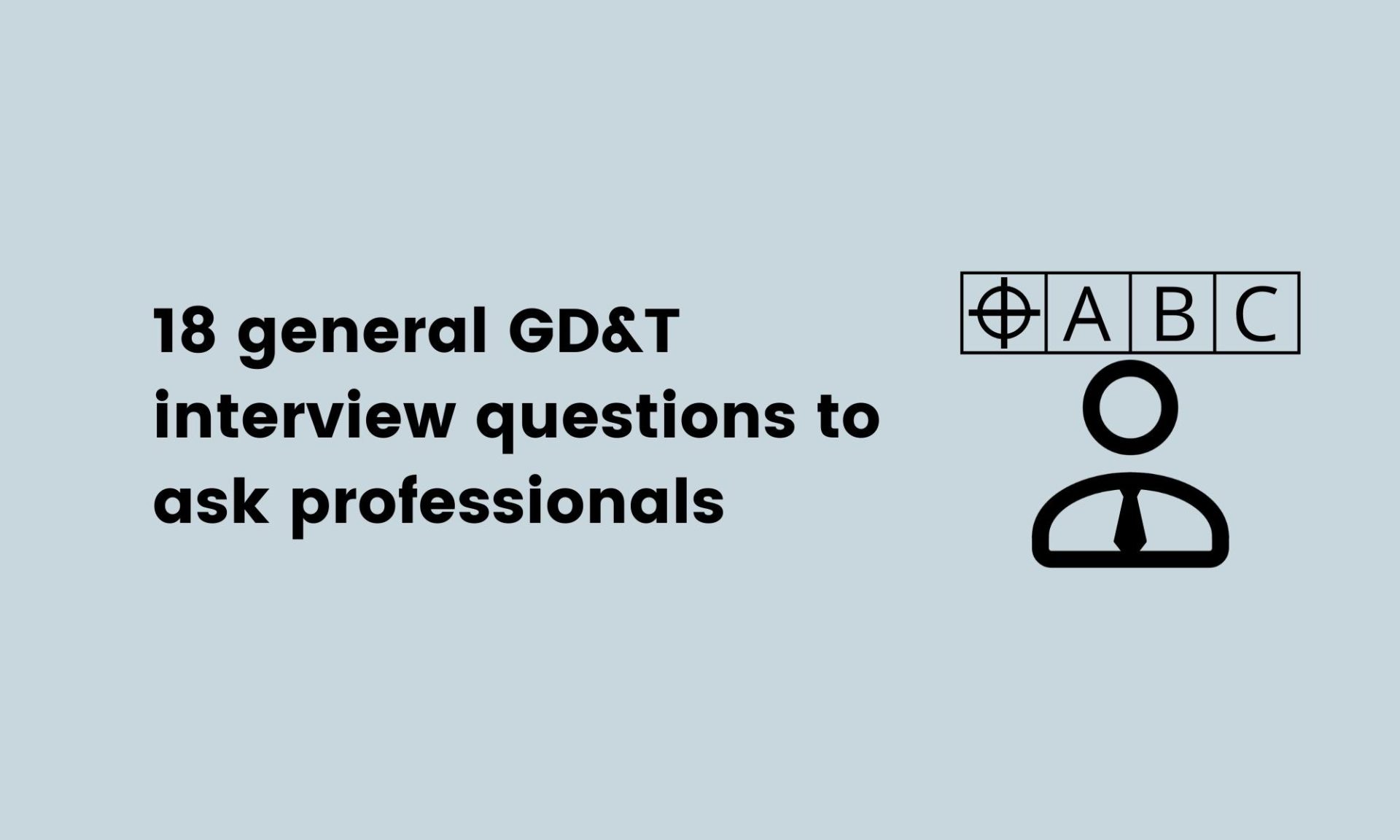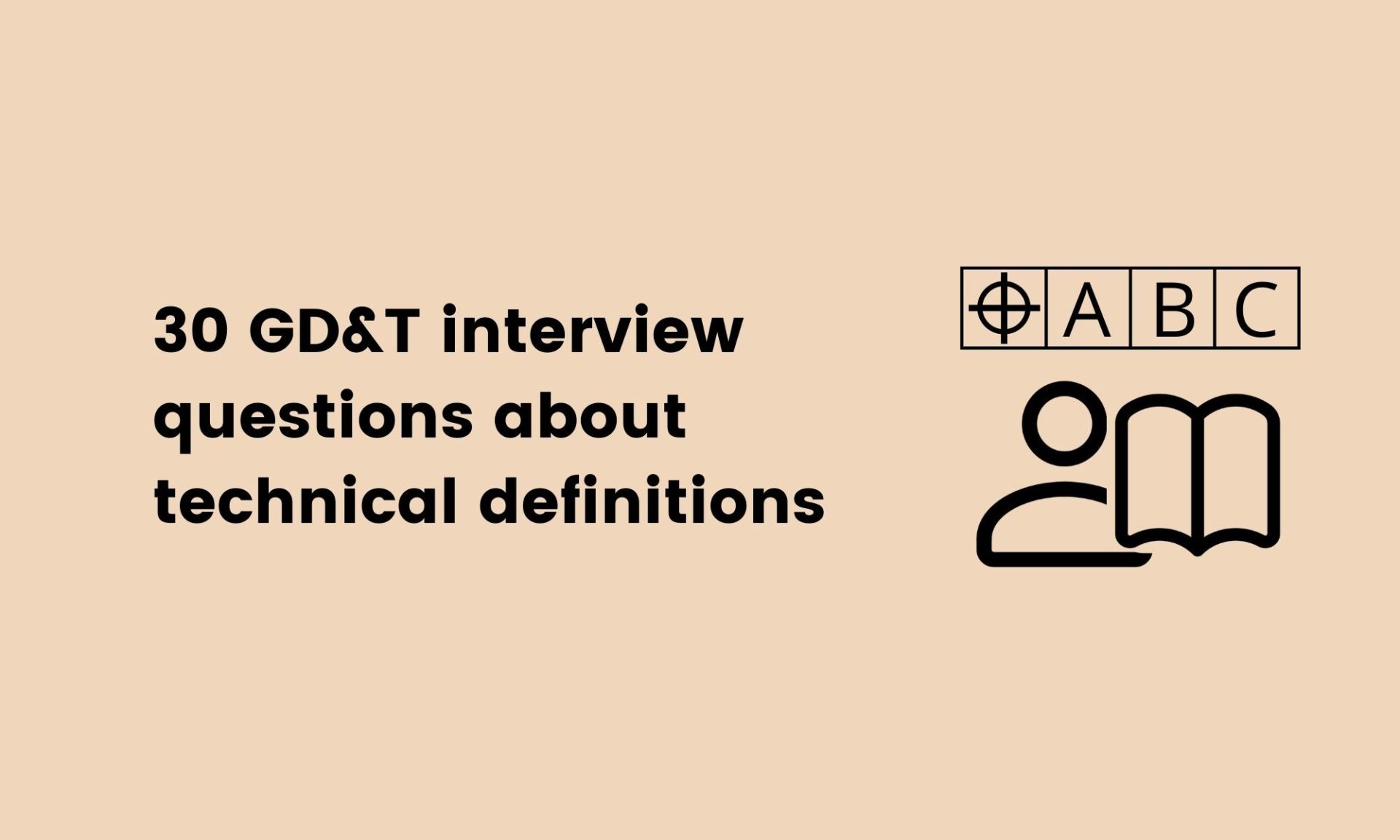So, you’re searching for the right GD&T engineer to join your business.
You already know that you need to assess a few different skills, including their Geometric dimensioning & tolerancing (GD&T) skills, but you might not be sure how to evaluate your applicants’ knowledge.
So, how can you guarantee your applicants have the level of expertise you need? What’s the best approach to gauge their skills?
Here’s how to do it: Use skills testing and the right GD&T questions when interviewing your applicants.
If you need inspiration for the questions to ask, we’ve got you covered.
In this article, you’ll find 53 GD&T interview questions to make hiring effortless.
Table of contents
- 18 general GD&T interview questions to ask professionals
- 5 general GD&T interview questions and answers
- 30 GD&T interview questions about technical definitions
- 5 GD&T interview questions and answers about technical definitions
- 5 GD&T interview questions and answers about processes and situations
- 7 tips for using GD&T interview questions
- Hire the best engineers using our GD&T interview questions
18 general GD&T interview questions to ask professionals
Ask interviewees some of these 18 general GD&T interview questions to evaluate their knowledge of critical GD&T terms, processes, and standards.
Explain what GD&T means.
Explain why GD&T is essential.
When should you use GD&T?
Name five different examples of GD&T tolerances.
Name five different examples of modifiers in GD&T.
Which skills do engineers working with GD&T need?
Which soft skills do engineers working with GD&T need?
Which skills do you need to improve?
How is dimensional tolerance different from geometric tolerance?
What is ASME Y14.5?
Name the main orientation tolerances.
Name the main profile tolerances.
Name the main form tolerances.
Name the main location tolerances.
Name the main runout tolerances.
Explain what geometry is.
Explain what dimension means.
What is the total number of GD&T symbols?
5 general GD&T interview questions and answers
Here are the answers to five of the general GD&T interview questions to help you gauge your interviewees’ knowledge and assess their responses.
1. Which skills do engineers working with GD&T need?
Your applicants should know that Geometric dimensioning & tolerancing knowledge is essential for engineers working with GD&T.
Can they also name a few sub-skills required to work as a GD&T engineer, such as datum referencing knowledge and symbology? Can they show that they have these skills and give examples of projects where they have used them?
2. What is ASME Y14.5?
Candidates should know that ASME is the American Society of Mechanical Engineers, while ASME Y14.5 is the organization’s standard for the rules, definitions, requirements, symbols, and best practices of GD&T.
They should be able to explain that there are several ASME standards and that engineers should know these standards confidently.
Can they also clarify that the ASME standards are updated at intervals of approximately 10 years?
3. What is the total number of GD&T symbols?
Do your applicants know that there are 14 types of GD&T symbols? Can they give a few examples of the symbols, such as the profile of a line or the profile of a surface?
4. Which soft skills do engineers working with GD&T need?
Skilled applicants should know that visual attention to detail is critical for engineers working with GD&T. They should also know that strong collaboration and communication skills are also essential for engineering roles.
5. Explain why GD&T is essential.
Can your candidates explain that GD&T is vital for the design process of mechanical products? Are they aware that GD&T helps maintain precision and accuracy in the design of mechanical products?
Candidates should also know that GD&T allows engineers to define the nominal geometry of parts and assemblies.
30 GD&T interview questions about technical definitions
Ask your interviewees some of these 30 GD&T interview questions about technical definitions to reliably assess their skills and knowledge.
Explain what straightness is.
Explain what flatness is.
Explain the main difference between straightness and flatness.
Explain what circularity is.
Explain what cylindricity is.
Explain the main difference between circularity and cylindricity.
Explain what the profile of the line means.
Explain what the profile of the surface means.
Explain why profile control tolerances are essential in GD&T.
Explain what LMC means.
Explain what MMC means.
Explain what feature control frames are.
Explain what the tolerance zone is for perpendicular tolerance in GD&T.
Explain what virtual conditions are in GD&T.
Explain what form of control is in GD&T.
Explain what unilateral tolerance is.
Explain what bilateral tolerance is.
Explain what geometric tolerance is.
Describe the symbol used to indicate straightness.
Describe the symbol used to indicate flatness.
Describe the symbol used to indicate circularity.
Describe the symbol used to indicate perpendicularity.
Describe the symbol used to indicate parallelism.
Describe the symbol used to indicate concentricity.
Describe the symbol used to indicate symmetry.
Describe the symbol used to indicate the profile of a surface.
Describe the symbol used to indicate angularity.
Describe the symbol used to indicate a circular runout.
Describe the symbol used to indicate total runout.
Describe the symbol used to indicate the profile of a line.
5 GD&T interview questions and answers about technical definitions
Here are the answers to five of the GD&T interview questions about technical definitions from the list above.
Use them to evaluate the thoroughness of your candidates’ responses.
1. Explain what MMC means.
Can your candidates explain that MMC means “maximum material condition”? Can they demonstrate that MMC is a condition where a feature contains the largest amount of material within the size limits?
2. Explain what LMC means.
Applicants should know that LMC means the “least material condition”. They should be able to explain that LMC refers to a condition where a feature contains the smallest amount of material within the size limits.
3. Explain what the tolerance zone is for perpendicular tolerance in GD&T.
Do your applicants know that the tolerance zone for perpendicular tolerance either refers to parallel surfaces that run perpendicular to a datum plane or a cylinder boundary that surrounds a true axis?
Can they explain that controlled surface points should lie inside the tolerance zone and that for axes, the points must lie inside the cylindrical boundary?
4. Describe the symbol used to indicate parallelism.
Applicants should know that the symbol used to indicate parallelism shows two parallel lines angled slightly to the left with a small space between them. They may also explain that the lines in this symbol are the same length.
5. Describe the symbol used to indicate symmetry.
Your candidates should know that the symbol used to indicate symmetry has three horizontal lines. The symbol features one long line in the center of two shorter lines, which are equidistant from the long line in the middle.
5 GD&T interview questions and answers about processes and situations
Ask your interviewees these five GD&T interview questions about processes and situations, and use the answers below to assess your candidates’ responses.
1. How would you measure perpendicular tolerance?
Can your applicants explain a few methods engineers can use to measure perpendicular tolerance? They may provide the following examples when responding to this question:
Use a surface gauge and a square ruler block
Use a VMM or CMM machine
Use a dial gauge
2. When would you use runout tolerance?
Your applicants should know that engineers use runout tolerance when they need to control the entire cylindrical or circular feature variation as the part rotates around the datum axis.
Applicants may also explain that engineers use total runout and circular runout for rotating shafts, including vehicle axles and engine transmission parts.
3. For which GD&T tolerances would you use the datum plane?
Can your applicants explain that a few tolerances require a datum plane? Knowledgeable applicants may list the following examples of tolerances engineers use in this instance:
** add a graph
Symmetry
Concentricity
Total runout
Circular runout
Position control
Parallelism
Angularity
Perpendicularity
4. When would you use MMC in GD&T?
Applicants should know that engineers can use MMC in GD&T to gain extra tolerance. Can your applicants also explain that engineers frequently use MMC during clearance fits or to indicate the mating parts’ tolerance?
5. Which skills would you use to measure perpendicular tolerance?
Do your candidates know that visual attention to detail is vital for measuring perpendicular tolerance? Knowledge of particular tools, such as dial gauges and VMM machines, is also essential. Can they show they have the required attention to detail and understanding of the tools necessary to measure perpendicular tolerance?
7 tips for using GD&T interview questions
Below, you’ll see our seven tips for using the GD&T interview questions from this article.
Review them before you start interviewing your applicants.
1. Send skill assessment invitations after sourcing candidates and before interviews
We recommend using skills tests early on in the recruitment process, right after you receive candidates’ applications to your job listing.
If you choose TestGorilla as your skill assessment platform, you can invite applicants to take a skills assessment (consisting of up to five tests) with a single click. You can also integrate the platform with your own ATS or simply copy the link and send it to applicants via email.
Make sure you’ve included the GD&T test as part of the assessment to evaluate applicants’ technical knowledge.
2. Use general interview questions to get the ball rolling
Before you begin with GD&T interview questions related to technical definitions, get the ball rolling by asking a few general questions. This will help you make your candidates feel more at ease and will give you information on their background and motivation.
Some of the following questions are good options to learn more about applicants early in the interview:
What made you apply for this position?
Talk about your GD&T and design engineering skills.
How do you make sure to keep your GD&T skills and knowledge up-to-date?
Describe your engineering career so far.
3. Give candidates more information about the open role
Now’s the time to expand on the information you’ve given applicants in the job ad. Give more details about the role and explain some of the projects your team has been working on.
4. Avoid unstructured interviews and closed-ended questions
Unstructured interviews can lead to unconscious bias because they leave a lot of room for small talk. If you want to ensure that evaluating your applicants’ responses is straightforward and unbiased, use a structured interviewing approach.
It’s also a good idea to use specific open-ended questions. For example, don’t ask, “Have you used VMM machines before?” and ask, “Describe your experience or knowledge of VMM machines if you have used them.” With open-ended questions, you’re more likely to get detailed answers from your applicants.
5. Record candidates’ responses by taking notes and using scoresheets
The notes you take can jog your memory when reviewing your applicants’ responses. Use scoresheets to make your job easier and collect data from your applicants when they respond to your GD&T interview questions.
6. Give good news to the best candidate and feedback to silver medallists
Next on your agenda is to review all the data you have collected and give the good news to the candidate who meets all your requirements.
At the same time, you should try to give helpful feedback to silver medallists. For example, if their datum referencing knowledge didn’t shine through on this occasion, use their skill assessment results to provide them with helpful advice on the ways they can improve.
This approach enhances the candidate experience and your reputation as an employer.
7. Put together a training and onboarding schedule
Your new hire is now ready to join your team. Ensure that you put together an appropriate training and onboarding schedule to make onboarding as easy as possible.
For the training schedule, you can take your new hire’s skill assessment results into account and plan accordingly. For instance, if your new hire didn’t know all GD&T best practices, make sure you include a section in your training schedule that helps them refresh their knowledge.
You’ll also know your new hire’s strongest skills: Consult the skill assessment to see in which areas they don’t need additional training.
Hire the best engineers using our GD&T interview questions
Even though hiring engineers can be difficult due to the complexity of the role and the many skills you must assess, the recruitment process doesn’t need to be complicated.
The best way to hire engineers is to use a skill assessment like the GD&T test by TestGorilla, along with the right interview questions.
Remember, when hiring engineers, follow the two steps below:
Use skill-testing in the early stages of the hiring process
Use skill test results to identify the best candidates and invite them to an interview
This way, you’ll find out whether your applicants have the right GD&T knowledge you need. Use GD&T interview questions and our skills tests to hire a professional who fits your requirements. Sign up for a TestGorilla free plan.
Related posts
Hire the best candidates with TestGorilla
Create pre-employment assessments in minutes to screen candidates, save time, and hire the best talent.
Latest posts
The best advice in pre-employment testing, in your inbox.
No spam. Unsubscribe at any time.

Hire the best. No bias. No stress.
Our screening tests identify the best candidates and make your hiring decisions faster, easier, and bias-free.
Free resources
This checklist covers key features you should look for when choosing a skills testing platform
This resource will help you develop an onboarding checklist for new hires.
How to assess your candidates' attention to detail.
Learn how to get human resources certified through HRCI or SHRM.
Learn how you can improve the level of talent at your company.
Learn how CapitalT reduced hiring bias with online skills assessments.
Learn how to make the resume process more efficient and more effective.
Improve your hiring strategy with these 7 critical recruitment metrics.
Learn how Sukhi decreased time spent reviewing resumes by 83%!
Hire more efficiently with these hacks that 99% of recruiters aren't using.
Make a business case for diversity and inclusion initiatives with this data.























